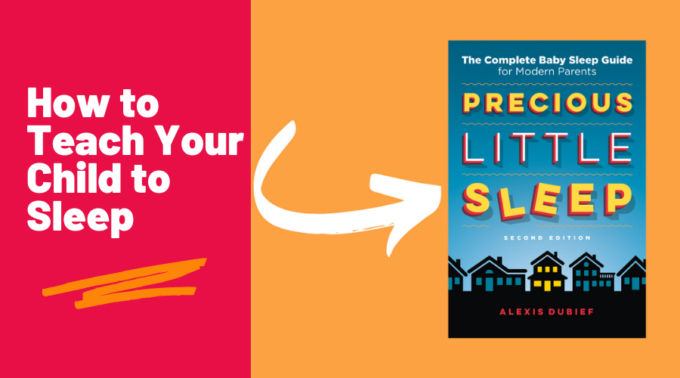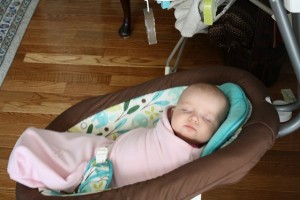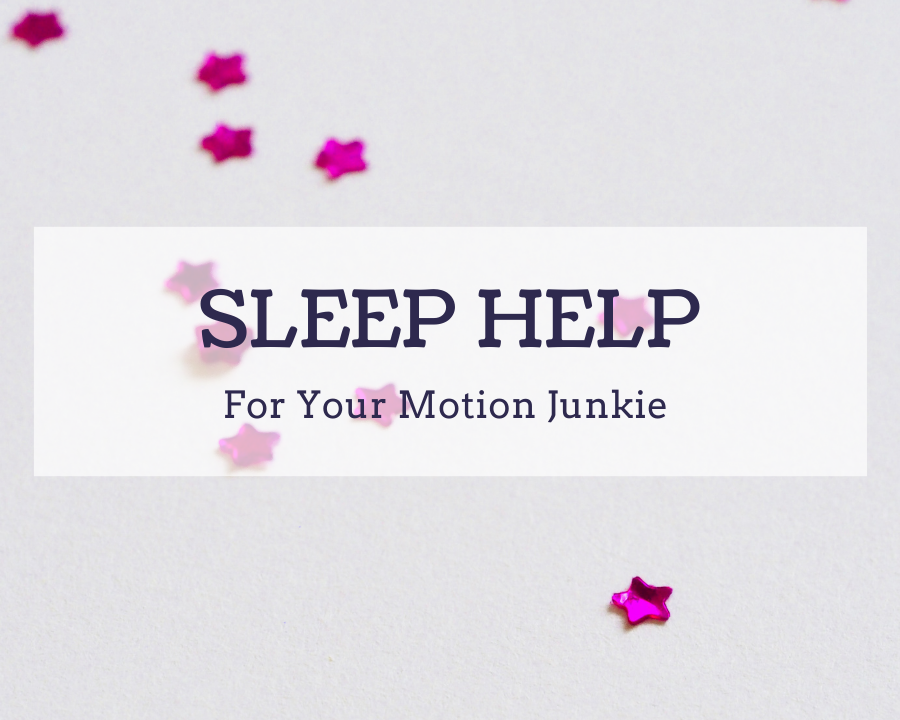Is your baby a motion junkie and you need to help them sleep better?
Great! You’ve come to the right place.
This post was originally written over a decade ago and we’ve learned a lot since then! The first thing is that swings are not safe for sleep and I no longer recommend them at all. I am leaving this post up because parents are still using them and looking for help for their motion junkies and I want to steer you in safer effective directions.
Are There Swing Alternatives?
Technically yes. The most notable is the SNOO which is a flat sleep space with no known safety issues. It is also exorbitant. It has a short usable window (primarily the newborn months). And I remain unconvinced that it makes a significant improvement in sleep outcomes relative to it’s cost. I’ve personally worked with many parents who use the SNOO who’s child slept no better or worse than those in a crib.
So … Then What?
Swings help by enabling motion to remain consistent throughout sleep. So you could effectively rock a baby to sleep in your arms, sneak them into the swing once asleep, and the swing would continue rocking them while you toddled off for a well-deserved nap. The swing made longer uninterrupted sleep possible because the motion (which is your child’s sleep association) was persistent (because the swing). When your baby cycles through light sleep, the motion, which is their sleep association, was still present and thus they were able to fall back into a deep sleep unassisted (by you).
If you rock a baby to sleep and sneak them into a crib (no motion) it is the safest place for them to be. However they will also be unable to cycle through light sleep without you and will wake ~30 minutes later because their sleep association – motion – is no longer present.
The key is to help your child to fall asleep without rocking. Because we know that independent sleep is the foundation to both good uninterrupted sleep and safe sleep (being able to sleep successfully in a crib or bassinet), rather than looking at technology (mechanical motion) to help solve our sleep woes we can go back to the basics – teach your child to fall asleep on their own. Because I promise you they can, from a very young age, without major tears or drama. Honest!
If you haven’t already, grab a copy of the Precious Little Sleep book. It’s been fully updated with multiple approaches to help you guide your little one so they master the ability to fall asleep without you rocking them to sleep. Then join the free FaceBook group for ongoing help and support. Your child’s sleep doesn’t have to be a misery and you don’t have to go it alone.

[The content below is here for posterity and because many parents are still using swings and thus searching for terms in this document. The advice here is no longer recommended]
Step 1: Buy baby swing.
Step 2: Assemble swing.
Step 3. Put baby in swing.
Step 4: Turn swing on.
What, it’s not working for you?
But My Baby Hates the Swing
I have never failed to get a baby to fall asleep. Contrary to what you may have heard, I do not do this by reading my blog posts to babies.
 If you are significantly struggling with sleep, short naps, etc. a swing might be helpful.
If you are significantly struggling with sleep, short naps, etc. a swing might be helpful.
Start with the basic baby swing steps:
- Discuss it with your pediatrician first.
- Put the swing where your baby currently sleeps (or sleeps most often). This is probably in your own room and it’s OK if it’s not currently THEIR room (we can easily move in that direction once we’ve mastered the swing). This is our new “sleep spot” and for the next few weeks, the baby should generally sleep in that location, in the swing, round the clock. (It’s OK if a few car/stroller naps sneak in there, it happens.)
- Make your sleep spot a dark place. Room darkening blinds work great for this. However you can temporarily create a dark space by simply taping aluminum foil to the windows with masking tape. Sure it’s a little ghetto but it works great!
- Put something in there that will create loud and continuous white noise. White noise will help your baby sleep.
- Set up your baby monitor.
- Move whatever other sleep supplies (swaddling blankets, pacifiers, books, chair for nursing/feeding, etc.) you need so that it’s relatively close to your new baby sleep spot.
- Put your swing into the sleep spot.
- Use your swing on the highest speed setting available.
Put the baby in the swing, strap them in, turn it on.
For some babies, it may be just this simple. If so, congratulations and I hope you are currently enjoying your victory nap.
Or maybe not. In which case we move on to what I like to call the Varsity Sleep Swing technique. We’re going to slather your baby with so much soothing that they will literally be incapable of staying awake. It’s like when I have 2 glasses of wine and then try to watch Masterpiece Theater, only modified for the younger set.
Varsity Sleep Swing Technique
All of the above PLUS:
- Swaddle your baby. Remember swaddling is all about the arms, having the legs wrapped up doesn’t add anything. So it’s totally fine to leave the legs loose so you can safely strap your baby into the swing with swaddled arms.
- Put something that smells like Mom near baby’s face. Like that t-shirt you’ve been living in for the past month because you’re too tired to deal with laundry. Cut off a small piece (~6″X6″ nothing large enough to become an entrapment hazard) and put it in the back of the swing near the baby’s face. When not being used for naps/sleeping keep this little piece of t-shirt tucked into your bra during the day so it always smells like you/milk.
- Use a pacifier. Some babies don’t take to pacifiers but if yours does then by all means use it.
- Jiggle their head.* Put your swaddled pacifier sucking baby in the swing in the dark room with the white noise. Crouch down behind the swing so they can’t really see you. Push the swing with your arm (the motor is off for now). If your baby is not calming or falling asleep, jiggle the back of the swing left and right WHILE you are swinging it back and forth. The goal here is to have your baby’s cheeks wiggling like a bowl of jello. (Here is a good video example of baby jiggling). You can also shoosh loudly (I know you are rocking the white noise already but for some reason the added shooshing seems to help). Keep it up for 2-3 minutes or until your baby starts to look tired. A great visual cue to look for is the sleepy blink – your baby starts to blink more slowly as though their eyelids are getting heavier. When you start to see sleepy cues turn on the swing motor.
- (Optional): Nurse baby to sleep while swaddled THEN put them in the swing.
*About head jiggling. This is what it sounds like – a jiggle. Shaken baby syndrome is an act of violence that requires forceful slamming motion. It is almost impossible to achieve this level of stress with a baby cradled in a swing but I want to be very clear that we are talking about jiggling vs. violent shaking.
Note: Your baby may be crying/complaining while you are swaddling her and strapping her into the swing. That’s OK. This probably means she’s a bit overtired – she may be short on sleep in general or maybe she was just kept awake a little longer than she could handle. Unless she is hungry this is a really good sign that she needs sleep so take a deep breath and continue to help her fall asleep in the swing.
Short-Term Sleep Swing Goals
I know some of you will feel like the swing is a detour because what you REALLY want is that peanut sleeping in his own crib. But the swing is going to solve two critical short-term issues:
-
Increase the Total Amount of Sleep
Babies sleep better and longer while moving. There is a reason most babies fall asleep seconds after you start the car. In general, babies will take slightly longer naps (+20-40 minutes) in a swing and newborns who are waking up a lot at night (4+ times) will often drop one of their night feedings after being put to bed in a swing.
-
Help Baby Learn to Fall Asleep.
Like potty training, getting the straw into the juicebox, and spitting, falling-asleep is a skill that you will need to help your child develop. Early on we help babies fall asleep primarily by rocking and nursing. However as your baby gets older these techniques will start to fail you (I’ll be writing a bunch about this later). If your goal is help your baby become a happy toddler who is capable of sleeping through the night then at some point you will have to help her learn to fall asleep. This can be a real challenge to do without any crying. Unless you use the swing in which case it’s really really easy.
Long-Term Sleep Swing Strategy
- You want to gradually wean off the swaddling, pacifier, and swinging. To wean off the swing, simply start turning the speed down. If naps & night sleep remains the same then continue. If she starts waking up more often, she’s not ready and the speed needs to stay up where it was. Wait a week or two, then try again. There is no rush.
- When you’re ready, move the swing next to the crib so that baby gets used to sleeping in that location.
- Eventually you’ll find yourself putting baby down for naps/bedtime in a non-moving swing. When you get to this point, the transition to the crib is relatively painless. The first time you put your baby in the crib there may be some “hey this is new?!?” complaining but it is generally mild and ends quickly.
- If your baby was happily sleeping in a non-moving swing, they SHOULD sleep just as happily in the crib.
Anybody else have any ideas on how to get those swing-hating babies to sleep in the swing?
{Photo credits: Bart Cicuto and Pat David}
